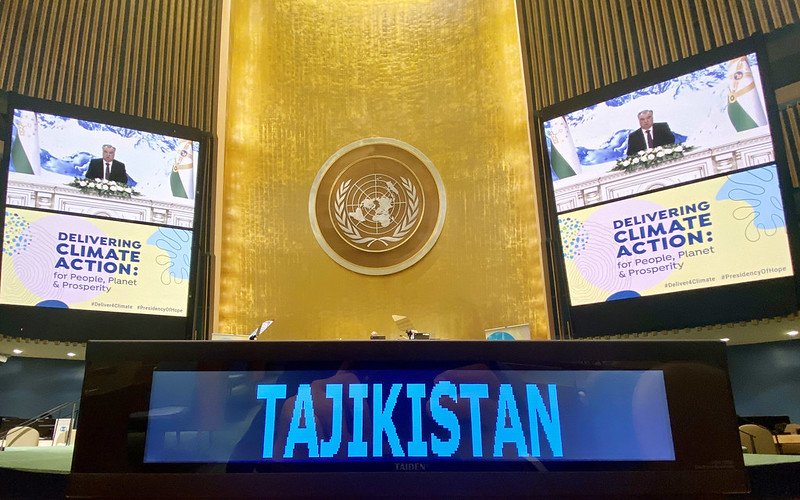Tajik President Emomali Rahmon has suggested that the UN declare 2025 as the International Year for Glaciers Preservation and set a specific date when the world can celebrate the World Glaciers Day while speaking at the 76th session of the UN high-level meeting on Delivering Climate Action: for People, Planet, and Prosperity.
Presided over by UN General Assembly President Abdulla Shahid, the High-Level Meeting on Delivering Climate Action for People, Planet and Prosperity took place at the UN General Assembly Hall on October 26.
The event reportedly heard from more than 70 Heads of State, Heads of Government and Ministers on actions to solve the climate emergency.
In his speech to the plenary, at the Opening Segment, President Abdulla Shahid said that it was important to hear “blunt realities” and to produce “an honest assessment of the challenges before us, and on an understanding that we have the combined capacity to confront those challenges, if we work together.”
The PGA mentioned that “there are reasons to be hopeful with the renewables now significantly undercutting fossil fuels as the world’s cheapest source of energy” but the goal of $100 billion per year in climate financing has not been met as of yet.
 ИЗОБРАЖЕНИЕ
ИЗОБРАЖЕНИЕ
Emomali Rahmon virtually attended the event.
“Our glaciers are melting fast water resources are decreasing at an outstripping pace. Floods, droughts and other hydrometeorological phenomena are becoming more frequent and cause significant damage to the country's economy, and thereby, undermining our efforts to achieve sustainable development,” Rahmon said
"Taking this opportunity, I would like to reiterate Tajikistan's proposals to declare 2025 as the International Year for Glaciers Preservation and to set a specific date for the World Glaciers Day. Tajikistan has called on the international community on multiple occasions to establish an International Fund for Glacier Preservation to enable us to jointly mobilize our efforts and resources to take practical steps in protecting glaciers as the main source of clean water," the president said.
Rahmon promised that Tajikistan will continue its efforts to save water resources at national and regional levels adding that Tajikistan reiterates its commitment to further prioritize its climate change agenda.
The president further noted that Tajikistan positively contributes to the prevention of global warming as the country's global emissions are the lowest, accounting for just 0.0003%.
Tajikistan is also committed not to exceed its greenhouse gas emissions and is aiming to reduce CO2 emissions by using large sources of renewable energy.
The 76th session of the UN high-level meeting on Delivering Climate Action: for People, Planet, and Prosperity commenced on October 26 and will address climate action ahead of COP26 UN Climate Change Conference which will commence in Glasgow next week.
Tajikistan has more than 8,000 glaciers, 19 of them large. They are involved in feeding the main rivers of the republic and during the hottest days of summer they give fresh water, which is very necessary not only for Tajikistan, but also for other countries of the Central Asian region. In recent decades, under the influence of climate change, some large glaciers have shrunk and retreated by kilometers. Scientists argue that the melting of glaciers is virtually irreversible, and the industrial age has only accelerated the process.
Tajikistan is the leader in the number of glaciers in Central Asia. Although glaciers cover only 6-8% of the country’s territory (8,476.2 square kilometers), they hold several hundred cubic kilometers of fresh water. The main share of glaciation is concentrated in the territory adjacent to the highest peaks of the republic – the peaks of Somoni and Abu Ali ibn Sino.
Large glaciers in Tajikistan feed the Amu Darya and Zeravshan river systems, whose water flows down to the downstream countries – Uzbekistan, Turkmenistan and Kazakhstan. Therefore, it is customary to say that most of the region’s water is generated in Tajikistan.




